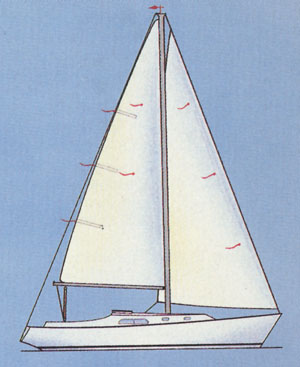

Telltales Improve Your Sailing Performance
A guide to installing and reading telltales
by Aaron Jasper (Printed in Cruising World)
Some old salts refer to telltales as training wheels, preferring instead to watch the luffs of their sails as a guide to trimming sails and steering the boat. Yet telltales provide a far more accurate indication of optimum sail trim and course to steer than do the sails themselves. Not using them is like relying on your senses of hearing, touch and smell rather than your engine gauges to determine if your engine is operating efficiently.
Just as an engine needs regular tune-ups in order to run at maximum efficiency, so do your sails. Sails change shape with age and use. As you buy new sails, recut old ones and change the way your rig is tuned, you should also change the way you set and trim individual sails for maximum efficiency. Telltales will enable you to get the best performance from any boat, whether it is yours or someone else's.
How To Install Telltales
Telltales should be,light in weight for maximum sensitivity. They should be dark or very bright in color to contrast with sails. A length of eight to 10 inches is about right. Favorite materials are yarn, spinnaker cloth strips or cassette recording tape. They can be attached to the sail with a piece of sticky tape or stitched through the cloth with a sail needle, then knotted on each side of the sail.
To install telltales on a headsail first divide the length of the luff into quarters. On the starboard side of the sail, about one foot aft from the luff, I attach a telltale to the sail at 1/4,1/2 and 3/4 height increments. Then flip to the port side and attach a telltale about six inches below each one on the starboard side. The lowest set of telltales should be visible to the helmsman when sailing to windward. If it isn't, go forward while sailing and stick a pair of telltales on the headsail as high as can be comfortably seen by the helmsman.
On the mainsail, attach one telltale right on the leech at each batten pocket or at 1/4, 1/2 and 3/4 intervals along the leech. You should also install telltale sets in the middle of the mainsail (halfway between the luff and leech) at 1/2 and 3/4 heights.
How To Read Telltales
CORRECT JIB SHEET LEAD POSITION - Genoa telltales will help you find the optimum jib sheet lead position fore and aft. This is found by observing the lower and upper telltales on the windward side of the jib while slowly turning up into the wind. If the upper telltale breaks (lifts and twirls) first, move the sheet lead forward. If the lower telltale breaks first, move the lead aft. The windward telltales should break together when the sheet lead position is correct.
READING JIB TELLTALES - When sailing to windward: Telltales on both the windward and leeward side of the jib should stream aft. If the leeward telltales twirl, steer closer to the wind. If the windward telltales lift and twirl, head off. Always turn away from the breaking telltale.
When reaching: While the helmsman maintains the desired course, ease the sheet if the leeward telltales drop or twirl. Trim the sheet if the windward telltales drop or twirl.
When running: With the jib eased fully out, airflow is reversed and telltales are of little help.
READING MAINSAIL TELLTALES
When sailing to windward, the leech telltales on the mainsail should all stream aft. If you move the traveler to windward, the top telltale should break first, followed shortly by the lower ones. If the bottom leech telltale breaks 'first, increase leech tension. It is difficult to get the mid telltales on the windward side of the mainsail to stream without those on the leech breaking. To get the mid telltales to stream, flatten the mainsail. If the bottom one streams, but not the top one, increase leech tension, pulling the top of the main to windward.
When reaching, it is less important that the leech telltales stream and more important that the windward mid telltales stream. However, don't overload the helm by overtrimming. Keep the rudder angle to a minimum for fast sailing and easy steering.
Install telltales on both sides of the headsail about one foot abaft the luff at 1/4, 1/2 and 3/4 intervals. On the mainsail, install leech telltales at each batten pocket, ;lus mid telltales at 1/2 and 3/4 heights.
Guide to Sail Trim
Click to Read
(go to www.adobe.com to get the latest version of acrobat reader, free)



